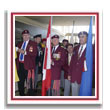|

It is estimated that between 7,000 to 12,000 Aboriginal
Peoples fought for Canada in the Korean War and in World Wars I
and II. 35 per cent of those who were eligible to enlist did
so—the highest among all ethnic and cultural groups in Canada.1
Because accurate records were not kept, the actual number of
Aboriginal soldiers who fought in the wars will never be known.
For many of the young men, enlisting provided an opportunity
to assert their manhood. For others, it was simply a way to
venture past the small prairie communities where they had been
raised, and into the outside world. For almost all, the overseas
journey alone brought with it life-changing goals and
challenges, from learning to speak English to dealing with
culture-shock and discrimination.
It did not take long, however, for both the Canadian military
and for enemy soldiers to discover that Canada’s Aboriginal
troops were some of the finest there were. Their traditional
hunting expertise and ability to move discretely and efficiently
through land helped them carry out dangerous tasks with great
proficiency. Many of the Aboriginal troops possessed precise aim
and they were assigned to sniping— a task in which they
excelled. They also fulfilled vital positions in reconnaissance
missions, which involved slipping past enemy lines to determine
the enemy’s location and weapon power and secretly relaying this
information back to their side of the fighting lines.2
Another important role, and often one that could only be
filled by an Aboriginal soldier, was that of code-talker.
Military messages were translated into Aboriginal languages such
as Cree, which were unique to North America and which even the
most skilled infiltrators had trouble decoding. A Cree soldier
on the receiving end would translate the message back into
English before passing it on to military officials.
The courage and the relentless spirit displayed on the front
by the Aboriginal troops earned them a laudable reputation as
well as numerous medals and commendations. Throughout the wars,
thousands of letters from the battlefront were sent to Indian
and Northern Affairs Canada commending Aboriginal soldiers.3
The contributions of the Aboriginal Peoples to the war effort
were not limited to the fields of Europe. On the home front,
Aboriginal farmers increased production, while women organized
Red Cross and Salvation Army societies and gathered provisions
to send overseas. Bands offered financial aid by purchasing war
certificates or donating a portion of their annual treaty
payments to the national treasury.4 Many generously gave up
reserve land to be used as defence posts, airports, and rifle
ranges.5
Sadly, it took more than fifty years for the government to
recognize the wartime contributions of the Aboriginal Peoples,
on the home front and battlefront alike. Overseas, Aboriginal
soldiers fought proudly alongside Canadian men of many other
races, fuelled by a shared purpose and pride. Upon their return
to Canadian soil, however, many First Nations, Inuit, and Métis
soldiers found that this equality no longer held. They received
no warm welcome. In fact, many came back to find that their land
had been taken away or divvied up among non-Aboriginal farmers
to increase wartime crop production, never to be theirs again.
They also found that they would not share in the same benefits
that other members of the Canadian forces enjoyed, including
educational and vocational training, employment offers, and
housing.
For years, Aboriginal veterans dealt with the harsh memories
of war, all the while struggling with the painful realization
that their wartime efforts seemed to be of little worth to the
Canadian government. In 2002, almost six decades after the end
of World War II, First Nations veterans and their spouses were
offered settlements of $20,000. However, this deal overlooked
both non-status First Nations and Métis veterans. In response,
the National Métis Veterans Association launched a class action
law suit against the federal government in August 2002. They
also filed a claim to the United Nations Human Rights Commission
against Canada stating that the actions of the Canadian
government was in violation of two articles in the International
Covenant on Civil and Political Rights. The federal government
has responded to these requests by providing some funding
through existing programs and allocating more funds to recognize
the Métis veteran’s contribution during the wars. In November
2004, the federal government provided $50,000 for the Métis
Veterans Outreach Program, which will act to bring information
to Métis veterans about the benefits now available to them. The
federal government provided an additional $50,000 for the
National Métis Veterans Association to produce a report on the
state of Métis veterans and to create a documentary about the
military contributions of Métis veterans and their experiences
upon returning to Canada.
In 1983, the Aboriginal Veterans Society of Alberta was
formed by Métis, First Nations, and Non-Status veterans, with
goals to remember and recognize the sacrifices of the soldiers.
In 2005, the Year of the Veteran, veterans gathered at the
Legislative grounds around a monument dedicated to the memory of
Aboriginal soldiers, which was unveiled in September of 2003.
The last of Alberta’s Aboriginal Veterans have united to
remember the struggles they faced as young men on the front, and
in the years following their return to Canada. They will not be
forgotten. |
 Heritage Community Foundation Presents
Heritage Community Foundation Presents




















